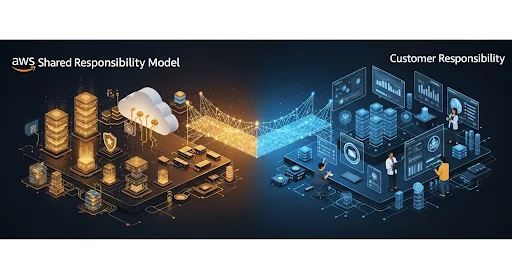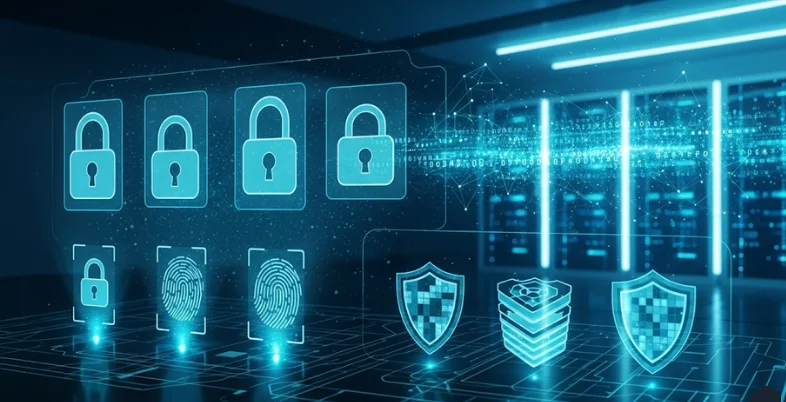As more organisations transfer their infrastructure to the cloud, AWS remains the top player in the market. However with scalability and innovation also comes the challenge of securing cloud environments against threats, misconfigurations and compliance failures. So let’s take a look at AWS security best practices and securing your cloud infrastructure.
AWS security is no longer just about using a few built-in tools; it’s about building a proactive, intelligent and holistic defence strategy. In a world where cyber threats continue to grow, businesses must now approach security as a dynamic and continuous process. Staying ahead of vulnerabilities and ensuring compliance with global standards requires not only technical solutions but also a commitment to security at every level of the organisation.
An Overview of AWS’s Shared Responsibility Model

This model defines the security roles and obligations of both AWS and its customers. AWS is responsible for securing the cloud infrastructure that runs all the services offered in the AWS cloud, including hardware, software, networking, and facilities. However, customers are also responsible for securing their data and workloads in the cloud, which encompasses configuring identity and access controls, enabling encryption, managing network settings, and keeping applications secure. Using CSPM Tools can help automate and enhance these security configurations to ensure compliance and reduce risks.
A common misconception is that using AWS means security is entirely outsourced. And while AWS provides a secure platform, it’s up to the customer to use it correctly. Without the right understanding of the model, gaps in security posture could emerge. This is typically due to misconfigurations or overlooked responsibilities on the customer side.
IAM and Access Control Best Practices

Identity and Access Management (IAM) is often the first line of defence in AWS environments. This manages who can access what and under which conditions. Least privilege is one of the most important concepts of IAM. This means each user or service should only be granted the permissions necessary to perform their specific tasks. This involves creating finely-tuned IAM policies and avoiding the use of overly permissive roles. Role segmentation is also important. Different functions within an organisation should have clearly separated permissions and access boundaries. This minimises the risk that a compromised user account can wreak widespread havoc.
Multi-factor authentication (MFA) is another non-negotiable element of access control in 2025. Every user, especially those with administrative privileges, should be required to authenticate using a second factor. This is typically a mobile device or hardware token. MFA provides a critical extra layer of security in the event that a password is stolen or leaked.
Data Protection with Encryption

Securing data is the most important aspect of AWS security. Encryption plays a major role in this effort. In AWS, data should be encrypted both at rest and in transit. Data at rest can be protected using AWS Key Management Services (KMS). This allows customers to create and manage cryptographic keys. Using KMS not only simplifies encryption but also ensures secure key lifecycle management. This includes rotation and access control.
Encryption in transit is just as important. Especially when it comes to sensitive information travelling through public networks. AWS supports secure communication through SSL/TLS and various VPN solutions. By encryption data in transit, organisations can ensure that it remains confidential and unaltered as it moves between the systems.
Encryption has become more than just a best practice. It’s now a regulatory necessity. With global standards like GDPR, HIPAA and PCI-DSS in effect. An organisation must be able to show that they are protecting its customers and business data properly. Failing to do this could lead to fines, reputational damage and operational disruptions.
Threat Detection Tools
Detecting threats before they escalate is an essential part of any security strategy. AWS provides a number of native tools with their cloud environments. AWS CloudTrail records API calls across your account. It offers a complete history of user activity. This makes it invaluable for auditing and forensic analysis.
AWS Security Hub aggregates findings from various AWS services and provides a centralised view of security and compliance status. It allows teams to triage alerts and prioritise remediation. By correlating data across multiple tools, Security Hub enhances situation awareness and speeds up incident response.
Continuous Compliance Monitoring with AWS Config
Achieving compliance isn’t enough in today’s regulatory environment. It must be maintained at all times. AWS Config allows organisations to assess, audit and evaluate the configurations of their AWS resources. It records configuration changes and compares them against desired states that are defined by compliance rules.
This kind of real-time oversight ensures that any deviation from policy is immediately detected. Organisations can use AWS Config to automate remediation actions, bringing non-compliant resources back into alignment without human intervention. This not only saves time but also ensures consistent application of security policies.
Continuous compliance is particularly valuable in industries with stringent regulatory requirements. It enables proactive governance and reduces the time, effort and cost associated with audits. More importantly, it minimises the risk of compliance-related security breaches.
The Benefits of Third-party Tools
While AWS offers a robust suite of native tools, many organisations choose to enhance their security posture with third-party platforms. One of the key advantages of this is to surface risks that are often overlooked by traditional tools. It correlates content from across the environment like vulnerabilities, secrets and misconfigurations and prioritises issues that are based on potential impact. This helps security teams focus on what matters most rather than getting lost in alert fatigue.
Evolving Threats and Proactive Strategies
As the cloud becomes more central to business operations, securing AWS environments is more important than ever before. It’s important to have a strategy that can adapt alongside evolving threats. Each part of AWS security plays an important roles, working together to defend digital assets.
AWS security in 2025 has become strategic. It’s not just about a technical challenge. Your success depends on embedding security into each and every layer of your cloud. An organisation that thrives is one that is able to anticipate change, embrace innovation and never stop working on its defences.



